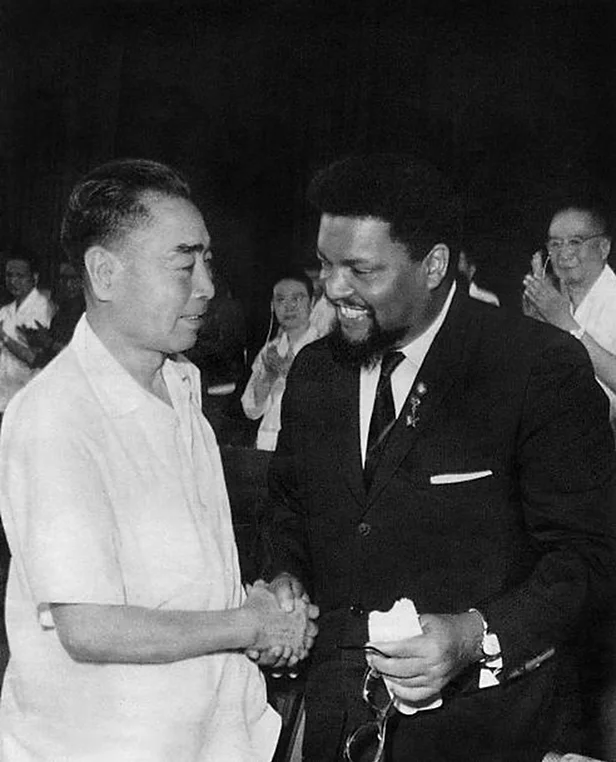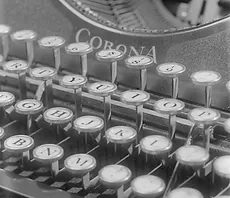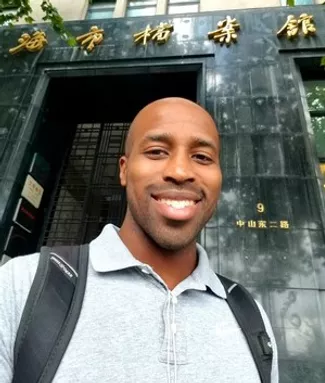Photo by Apic/Hulton Archive/Getty Images
Malcolm X’s 1964 speech at Cory Methodist Church in Cleveland, Ohio has become famous for its juxtaposition of the “ballot or the bullet.” Less remembered, however, is Malcolm’s call midway through his speech to “expand the civil-rights struggle to the level of human rights” and take it to China, where 800 million Chinese citizens were “sitting there waiting to throw their weight on our side.”
Malcolm was referring to the “Statement Supporting the Afro-Americans in their Just Struggle against Racial Discrimination by U.S. Imperialism,” issued by Chinese leader Mao Zedong on August 8, 1963.
With anti-colonial revolutions in full swing, African Americans increasingly turned abroad for inspiration and support, and while they found many allies around the globe, the People’s Republic of China became a vital source of solidarity for Black dissidents and revolutionaries during the 1960s and early 1970s.
But even before Malcolm X’s appeal to the crowd in Cleveland, activist Robert F. Williams had already turned his attention to China.
Williams is best known for calling on African Americans in Monroe, North Carolina to meet violence with violence. However, by the mid-1960s, the revolutionary lived in exile in China, via Cuba, after fleeing kidnapping charges in the United States.
Williams had just given a speech at a rally in Beijing celebrating the third anniversary of Mao Zedong’s statement of support and is seen here shaking hands with the Chinese Premier, Zhou Enlai, on August 8, 1966.
Bolstered by Zhou’s support, Williams declared that President Johnson,
“can no more intimidate the Afro-American people with his threat of unleashing his great hordes of mad-dog racists than he can intimidate the Chinese people with the threat of unleashing a nuclear attack. The day when brutal white racist oppressors and imperialists can frighten colored peoples into submission by threats of savage violence are gone forever!”

Photo by Apic/Hulton Archive/Getty Images
For the Chinese leadership, Williams was their first high-profile African American ally since W. E. B. Du Bois had died in 1963.
While the photograph gives off an air of cordial friendship, it fails to capture the political turmoil beginning to grip Chinese society and its political institutions. The Cultural Revolution had just begun, and four days earlier, at an enlarged meeting of the Politburo Standing Committee, Mao accused political leaders of “standing on the side of the bourgeoisie to oppose the Great Proletarian Cultural Revolution.”
The Cultural Revolution brought about the downfall of high-ranking Chinese officials like Deng Xiaoping, Liu Shaoqi, and Lin Biao, but it elevated Williams and other Black radicals in the years following this photo.
Williams’s call to meet violence with violence and his strong stance against the U.S. government made him a popular figure in China, while arguably more moderate activists like Martin Luther King Jr. came to be widely despised there. Williams returned to the United States three years after this photograph was taken, but he was not the last African American leader to look to China for support.

Photo by Bettmann Collection/Getty Images
In 1971, Zhou Enlai again greeted African American activists when Black Panther Party founder Huey Newton visited China. On the table at a press conference following his visit is a photograph of Newton meeting Zhou. The image is strikingly similar to the photograph of Williams’s meeting five years earlier.

Photo by Bettmann Collection/Getty Images
Not pictured is the political tightrope Newton is walking. The press conference was held roughly six months following his party’s split with more radically minded revolutionaries like Eldridge Cleaver and just five months before President Richard Nixon’s visit to China. At the conference, Newton spoke vaguely of gaining China’s support.
Zhou was balancing his own political challenges. At the time the photo was taken, the Cultural Revolution had raged on for six years. The revolution had restored Mao’s grip over the party, but at grave cost to China in human lives, economic growth, and social stability. China’s relationship with the Soviet Union had also grown increasingly antagonistic, marred by border conflicts that risked all-out war.
Although Zhou agreed to meet with Newton and other Black Panther Party members in October 1971, Chinese political leaders were already moving to foster better relations with the U.S. government. While hosting a banquet on October 5th, Zhou encouraged Newton and other Black Panther Party delegation members to drop their revolutionary rhetoric and promote cordial relations between the U.S. and China.
Zhou’s meeting with Newton ultimately became a part of his country’s efforts to normalize relations with the United States. The Chinese support that Newton alluded to at this press conference would never materialize.

Photo by Corbis Historical/Historical/Getty Images
Just months after the banquet with the Black Panthers, and against the backdrop of the Vietnam War, China openly began the process of normalizing relations with the U.S. government and embedding itself in international systems. Nothing symbolized that more than Nixon, here at the end of his trip to China, reviewing Chinese troops. Meanwhile, many African Americans believed that those international systems contributed to their problems.
Mao hoped to check the Soviet Union’s territorial ambitions by forming an alliance with the United States. For his part, Nixon hoped that normalizing relations with China would speed the U.S. exit from Vietnam. The racial discrimination faced by African Americans was not of significant concern for either party in 1972.
While this photograph represented a nascent friendship between two countries, it also represented a betrayal for many revolutionary-minded African Americans. Still barred from expressing the fullest extent of their rights, this change in political winds highlighted that while many African Americans invested considerable energy abroad, foreign allies often proved ready to divest themselves from their cause.
Ironically, the visible characters on the upper right-hand side of the photograph read, “oppressed peoples of the world unite.” Although the first two photographs captured moments when revolutionary Black liberation movements met the Chinese revolution, the final picture highlighted their divergence.






